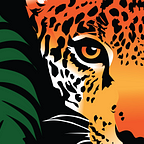Animals Shine Like Stars Through New Drone Technology
Alex Antram
Interdisciplinary analysis isn’t something new in science, conservation included. Indeed, interdisciplinary collaboration is necessary to address the complexities of conservation. Biologists, ecologists, geologists and others all can and do work together. But one recent disciplinary partnership has the potential to transform conservation scientists’ usual go-to partners.
I’m talking about astro-ecology.
Scientists in Borneo are combining the science of our world with the science of the beyond. An innovative project is monitoring great ape populations by harnessing technology used to study stars.
Critically Endangered Bornean Orangutans make their nests in the forest canopy. To estimate populations, researchers count those nests. This practice can be time and energy intensive, considering how orangutan troops move through dense rainforest.
But now, drones fitted with thermal-imaging cameras can detect nests — or rather, their warm-blooded inhabitants — from above.
Stars emit infrared radiation (heat), and infrared telescopes on Earth can sense heat from light years away. But animals, like stars (and all objects), also emit infrared radiation. Imagine how well animals’ heat signatures could be detected by thermal-imaging drones flying just 400 feet above the ground.
“In thermal images, animals shine in a similar way to stars and galaxies, so we used techniques from astronomy to detect and distinguish them,” said Dr. Claire Burke of the Astrophysics Research Institute at Liverpool John Moores University. “We were not sure at all whether this would work, but with the thermal-infrared camera we could see the orangutans quite clearly because of their body heat, even during fog or at night.” The breakthrough comes out of a partnership between the university, World Wildlife Federation and HUTAN — Kinabatangan Orangutan Conservation Programme.
Drones are not new to conservation. Conservation scientists used them for natural resource management, documenting tree canopy change, filming large mammal migrations or even surveying wildfires in real time.
But merging techniques long used in infrared astronomy with drone imaging is a game-changer. With this technology, conservation researchers can cover large expanses of difficult terrain in no time and cause less disruption to the animals and their habitat. And the difficult-to-find apes don’t need to be asleep to be under examination.
Scientists may be able to use this innovative technology to understand and monitor populations of other endangered species, especially in the wake of poaching, habitat loss and the ever-amorphous climate change. Along with the 41 orangutans spotted in this study, the astro-ecologists picked up proboscis monkeys and pygmy elephants with their thermal-imaging cameras.
They are now developing an algorithm to identify species based on their unique heat signatures. “In the future, we hope to be able to track, distinguish and monitor large numbers of different species of animals in real time, all around the globe, so that this technology can be used to make a real impact on conservation and stop poaching before it happens,” Dr. Burke concluded.
Alex Antram is the Conservation Outreach Manager at Rainforest Trust.
